Vulnerability Assessment of Mine Flooding Disaster Induced by Rainstorm Based on Tri-AHP
Abstract
1. Introduction
2. Literature Review
3. Methods
3.1. Assessment Model
3.2. Method of Tri-AHP
3.2.1. Construct a Triangular Fuzzy Judgment Matrix
3.2.2. Determine the Weight of the Evaluation Indicators
3.3. Assessment of Vulnerability
4. Case Study
4.1. Background
4.2. Survey of Disaster-Bearing Bodies
4.3. Weight Calculation
- (1)
- For this study, 7 experts in the coal industry from universities, scientific research institutes and enterprises are invited to discuss the importance of each influencing factor of vulnerability, with results shown in Table 7, where the Roman numerals indicate the number of times where the level of influence is selected.
- (2)
- On the grounds of the scoring table made by expert in evaluating the importance of the vulnerability influencing factors, the simple judgment matrix, E, F, and R (exposure, fortification level, and resilience), is constructed, respectively, as shown in Equations (11)–(13):
- (3)
- (4)
- Then, according to Equation (6), after obtaining all the confidence levels, the weights of exposure, fortification level, and resilience are worked out within Equations (7)–(9), as shown in Equations (14)–(16):
4.4. Vulnerability of Coal Min
5. Discussion
- In the exposure index, personnel have the highest weight, followed by assets, and then production capacity, with the lowest weight. The greater the personnel, assets and production exposed to the disaster factors, the higher the vulnerability of the disaster-bearing body. Among the 8 coal mines in Sanmenxia, Gengcun Coal Mine is exposed to the largest extent, and Liangjiawa Coal Mine is exposed to the lowest.
- The key elements of the fortification for rainstorm flooded well disaster mainly include elevation of wellhead, waterproof coal pillar, subsidence and crack area, abandoned wells, embankment project and others, whereinto, , and the weight of wellhead elevation occupies the highest weight. Among the 8 coal mines in Sanmenxia, the Gengcun Coal Mine enjoys the highest fortification level, while the Liangjiawa Coal Mine and Changcun Coal Mine share the lowest fortification level. Therefore, the elevation of the coal mine wellhead shall be higher than the highest flood level in the local years, the collapsed cracked area shall be backfilled and compacted in time, and the scrapped rockshaft shall be blocked timely.
- The impact factors of emergency capacity include emergency plan, emergency materials, early warning mechanism and management system, whereinto, , and the emergency plan enjoys the highest weight. Among the 8 coal mines in Sanmenxia, Changcun Coal Mine has the strongest emergency response capacity, while Guanyintang, Longwangzhuang and Jiuliuba coal mines behave the weakest in responding emergencies. Therefore, coal mines shall implement a special rainstorm emergency plan, regular rainstorm drills, update the emergency plan, and strengthen the emergency duty in the rainy season.
- Among the eight coal mines in Sanmenxia, Changcun Coal Mine is in a medium level of vulnerability. The other three mines, including the Gengcun Coal Mine, are in medium-low, while four others, including Guanyintang Coal Mine, are in low. Through field investigation, the assessment results are basically consistent with the actual situation of the coal mine. Therefore, coal mines shall strengthen the prevention of rainstorm disasters in accordance with relevant standards, norms, laws and regulations, reduce the vulnerability of rainstorm flooding disasters in coal mines, and ensure energy sustainability.
6. Conclusions
Author Contributions
Funding
Institutional Review Board Statement
Informed Consent Statement
Data Availability Statement
Conflicts of Interest
References
- Shi, Y. Research on regional differences of the policies for overseas talent introduction in China. World Reg. Stud. 2013, 22, 152–158, 175. [Google Scholar]
- Huang, H.; Wang, X.; Liu, L. A review on urban pluvial floods: Characteristics, mechanisms, data, and research methods. Prog. Geogr. 2021, 40, 1048–1059. [Google Scholar] [CrossRef]
- Liu, Y.; Tang, W.; Zhang, W.; Zhang, H.; Niu, S. Review of flood disaster risk analysis based on disaster chain. Water Resour. Prot. 2021, 37, 20–27. [Google Scholar]
- IPCC: Climate Change 2021: The Physical Science Basis. Available online: https://www.ipcc.ch/report/ar6/wg1/ (accessed on 1 November 2022).
- Lei, X.; Lai, C.; Wang, Z.; Zeng, Z.; Lin, G.; Zhao, J. Influence of LID adaptation on urban flooding and non-point source pollution. Water Resour. Prot. 2021, 37, 131–139. [Google Scholar]
- Xu, Z.; Ren, M.; Chen, H. Analysis on urban flooding risk caused by flood tide combination in coastal cities. Water Resour. Prot. 2021, 37, 10–14. [Google Scholar]
- Bueh, C.; Zhuge, A.; Xie, Z.; Gao, Z.; Lin, D. Water vapor transportation features and key synoptic-scale systems of the “7.20” rainstorm in Henan Province in 2021. Chin. J. Atmos. Sci. 2022, 46, 725–744. [Google Scholar]
- Wu, Q.; Tu, K.; Zeng, Y. Discussion on the main problems and countermeasures for building an upgrade version of main energy (coal) industry in China. J. China Coal Soc. 2019, 44, 1625–1636. [Google Scholar]
- China Coal Industry Association: 2021 Annual Report on Coal Industry Development. Available online: https://chinanpo.mca.gov.cn/xwxq?newsType=6000&id=18880 (accessed on 1 November 2022).
- Wang, G.; Li, S.; Zhang, J.; Pang, Y.; Chen, P.; Chen, G.; Du, Y. Ensuring the safety of coal industry to lay the cornerstone of energy security. China Coal 2022, 48, 1–9. [Google Scholar]
- Qi, Q.; Sun, Z.; Liu, W. Study on risk assessment model of coal mine water accident induced by flood disaster. Coal Sci. Technol. 2022, 1–10. [Google Scholar] [CrossRef]
- Li, L.; Wang, X.; Wang, H. Review of content, evaluation and research trends of vulnerability. Chin. Fish. Econ. 2010, 28, 161–169. [Google Scholar]
- Huang, X.; Huang, X.; Cui, C.; Yang, X. The concept, analytical framework and assessment method of social vulnerability. Prog. Geogr. 2014, 33, 1512–1525. [Google Scholar]
- Zhang, H.; Li, C.; Cheng, J. A review of urban flood risk assessment based on the framework of hazard-exposure-vulnerability. Prog. Geogr. 2019, 38, 175–190. [Google Scholar]
- Füssel, H.M. Vulnerability: A generally applicable conceptual framework for climate change research. Glob. Environ. Change 2007, 17, 155–167. [Google Scholar] [CrossRef]
- He, L.; Shen, J.; Zhang, Y. Ecological vulnerability assessment for ecological conservation and environmental management. J. Environ. Manag. 2018, 206, 1115–1125. [Google Scholar] [CrossRef]
- Sarker, M.N.I.; Wu, M.; Alam, G.M.; Shouse, R.C. Livelihood vulnerability of riverine-island dwellers in the face of natural disasters in Bangladesh. Sustainability 2019, 11, 1623. [Google Scholar] [CrossRef]
- Zhao, L.; Wang, Q. FCM-based vulnerability evolution analysis of metro systems under storm disturbances. China Saf. Sci. J. 2022, 32, 186–192. [Google Scholar]
- Zhao, L.; Wang, Q. Study on vulnerability formation mechanism of metro system under storm disturbance. China Saf. Sci. J. 2022, 32, 193–199. [Google Scholar]
- Zhou, J.; Zhang, H.; Wang, B. Spatio-temporal characteristics analysis of urban rainstorm and flood disaster vulnerability. Geospat. Inf. 2021, 19, 40–43, 79, 149. [Google Scholar]
- Huang, X.; Li, H.; Zhang, Y. Construction of urban waterlogging vulnerability assessment system and vulnerability assessment based on PSR & AHP method in Xi’an city. J. Natl. Disasters 2019, 28, 167–175. [Google Scholar]
- Ma, F.; Liu, F.; Yuen, K.F.; Lai, P.; Sun, Q.; Li, X. Cascading failures and vulnerability evolution in bus–metro complex bilayer networks under rainstorm weather conditions. Int. J. Environ. Res. Public Health 2019, 16, 329. [Google Scholar] [CrossRef]
- Zhu, G.; Fang, S.; Yin, C. Risk assessment of rainstorm-flood disaster based on FAHP-CRITIC: Taking Lintong District of Xi’an City as an example. Water Resour. Hydropower Eng. 2022, 1–17. [Google Scholar]
- Sun, Z.; Liu, Y.; Qi, Q.; Liu, W.; Li, D.; Chai, J. Risk assessment of coal mine flood disasters based on projection pursuit clustering model. Sustainability 2022, 14, 11131. [Google Scholar] [CrossRef]
- Jiang, S.; Li, J.; Zhang, S.; Gu, Q.; Lu, C.; Liu, H. Landslide risk prediction by using GBRT algorithm: Application of artificial intelligence in disaster prevention of energy mining. Process Saf. Environ. Prot. 2022, 166, 384–392. [Google Scholar] [CrossRef]
- Duan, X.; Zhang, Y.; Hou, X. Analysis of the road traffic system vulnerability based on the factor coupling method. J. Safe Environ. 2018, 18, 1749–1755. [Google Scholar]
- Yao, R.; Yang, Q.; Zhang, S. A review of vulnerability of urban rainstorm waterlogging disaster: Spatio-temporal cognition, measure and simulation. Water Resour. Prot. 2022, 1–12. [Google Scholar]
- Zhou, S.; Zhai, G.; Shi, Y. A literature review of urban natural disaster risk assessment. J. Catastr. 2020, 35, 180–186. [Google Scholar]
- Zhang, B.; Zhao, Q.; Jiang, Y. Research on indexes system about regional vulnerability of hazard-affected bodies and fine spatial quantitative model. J. Catastr. 2010, 25, 36–40. [Google Scholar]
- Nezarat, H.; Sereshki, F.; Ataei, M. Ranking of geological risks in mechanized tunneling by using Fuzzy Analytical Hierarchy Process (FAHP). Tunn. Undergr. Space Technol. 2015, 50, 358–364. [Google Scholar] [CrossRef]
- Ahmad, M.; Cheng, W. A novel approach of fuzzy control chart with fuzzy process capability indices using alpha cut triangular fuzzy number. Mathematics 2022, 10, 3572. [Google Scholar] [CrossRef]
- Eskandari, S.; Miesel, J.R. Comparison of the fuzzy AHP method, the spatial correlation method, and the Dong model to predict the fre high-risk areas in Hyrcanian forests of Iran. Geomat. Nat. Hazards Risk 2017, 8, 933–949. [Google Scholar] [CrossRef]
- Afolayan, A.H.; Ojokoh, B.A.; Adetunmbi, A.O. Performance analysis of fuzzy analytic hierarchy process multi-criteria decision support models for contractor selection. Sci. Afr. 2020, 9, e00471. [Google Scholar] [CrossRef]
- Harsha, G.; Anish, T.S.; Rajaneesh, A.; Prasad, M.K.; Mathew, R.; Mammen, P.C.; Kuriakose, S.L. Dengue risk zone mapping of Thiruvananthapuram district, India: A comparison of the AHP and F-AHP methods. GeoJournal 2022, 1–22. [Google Scholar] [CrossRef] [PubMed]
- Lyu, H.; Shen, S.; Zhou, A.; Yang, J. Perspectives for flood risk assessment and management for mega-city metro system. Tunn. Undergr. Space Technol 2019, 84, 31–44. [Google Scholar] [CrossRef]
- Ran, L.; Li, S.; Zhou, Y. Observational analysis of the dynamic, thermal, and water vapor characteristics of the “7.20” extreme rainstorm event in Henan Province, 2021. Chin. J. Atmos. Sci. 2021, 45, 1366–1383. [Google Scholar]
- The Rescue of the “July 29” Flooding Accident in Shanzhou District Was Carried out Orderly, 69 People Were Trapped Underground. Available online: http://www.gov.cn/govweb/jrzg/2007-07/30/content_700504.htm (accessed on 1 November 2022).
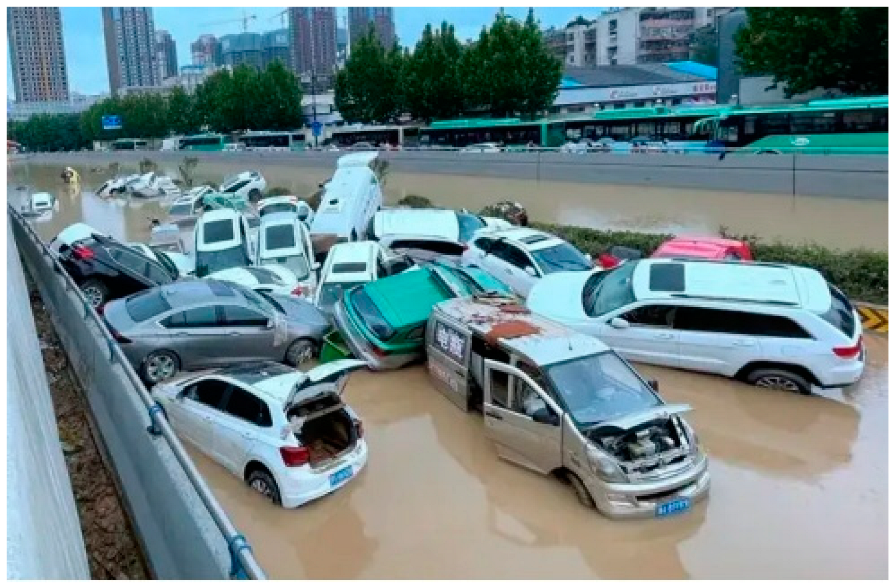
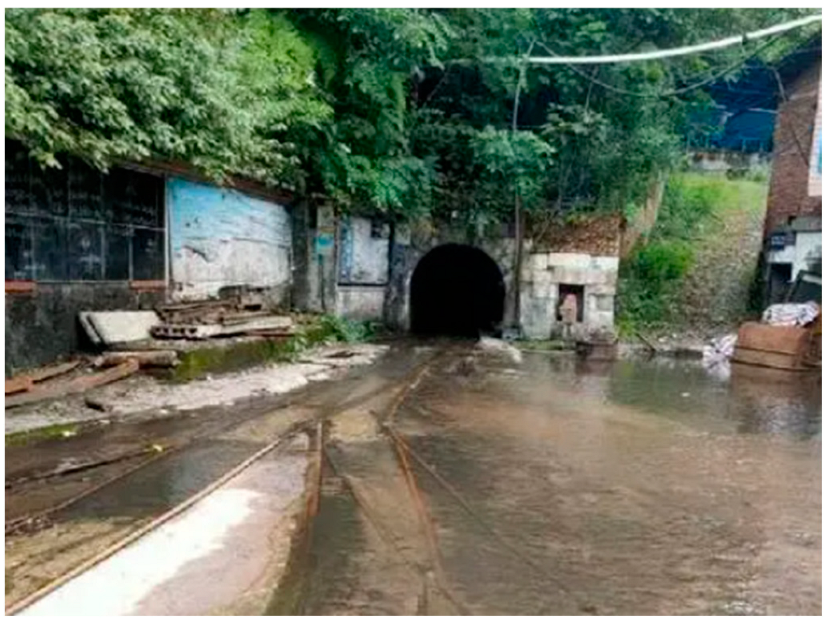

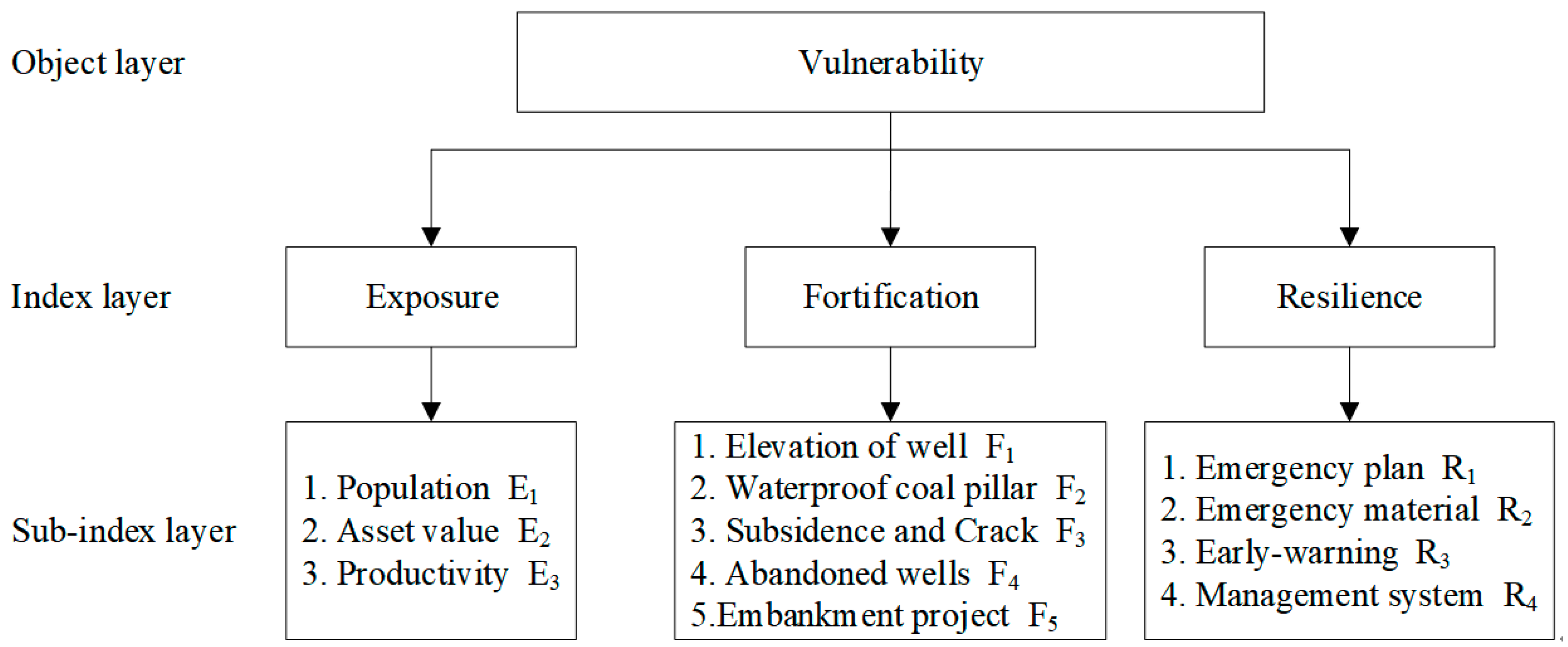
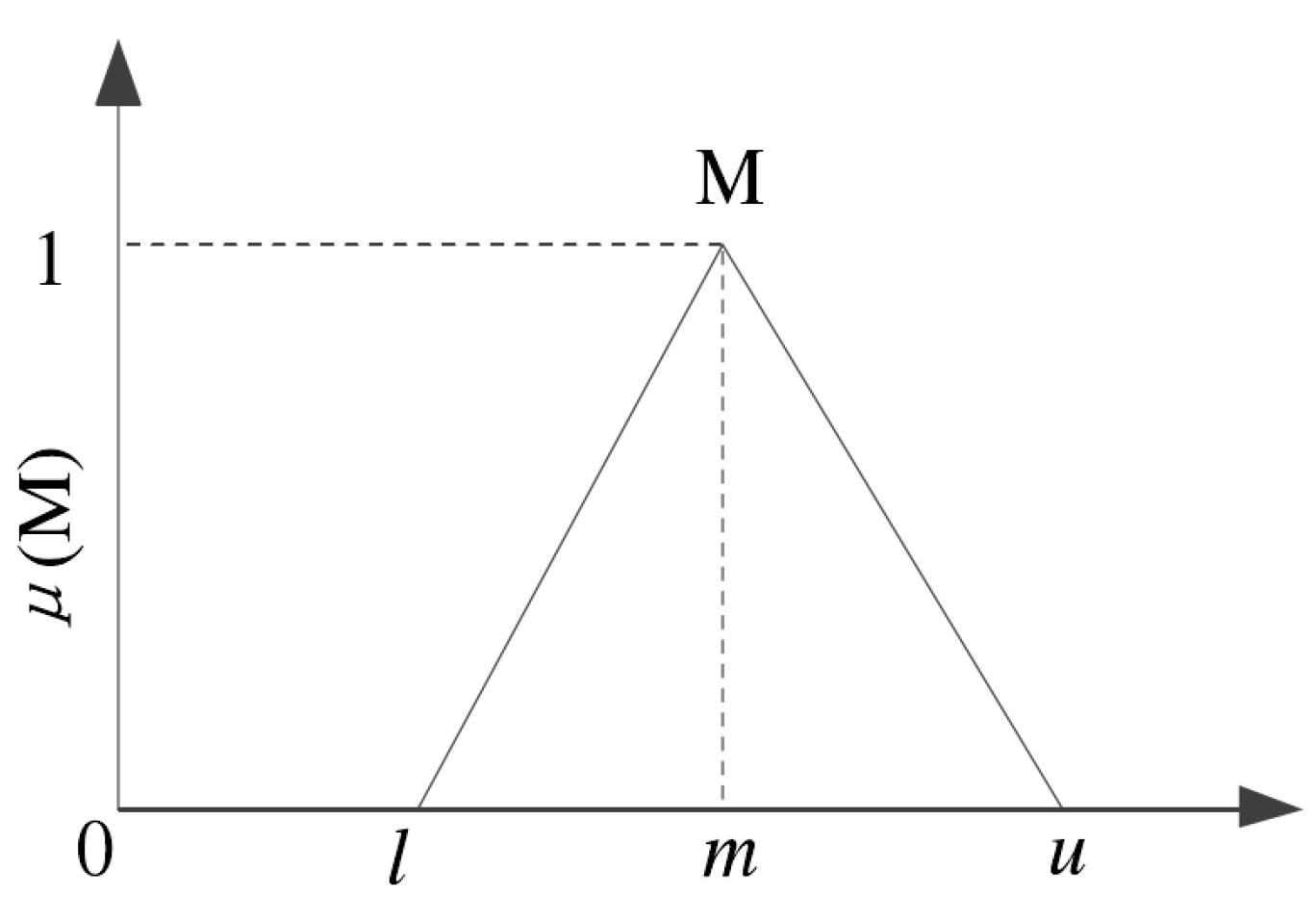
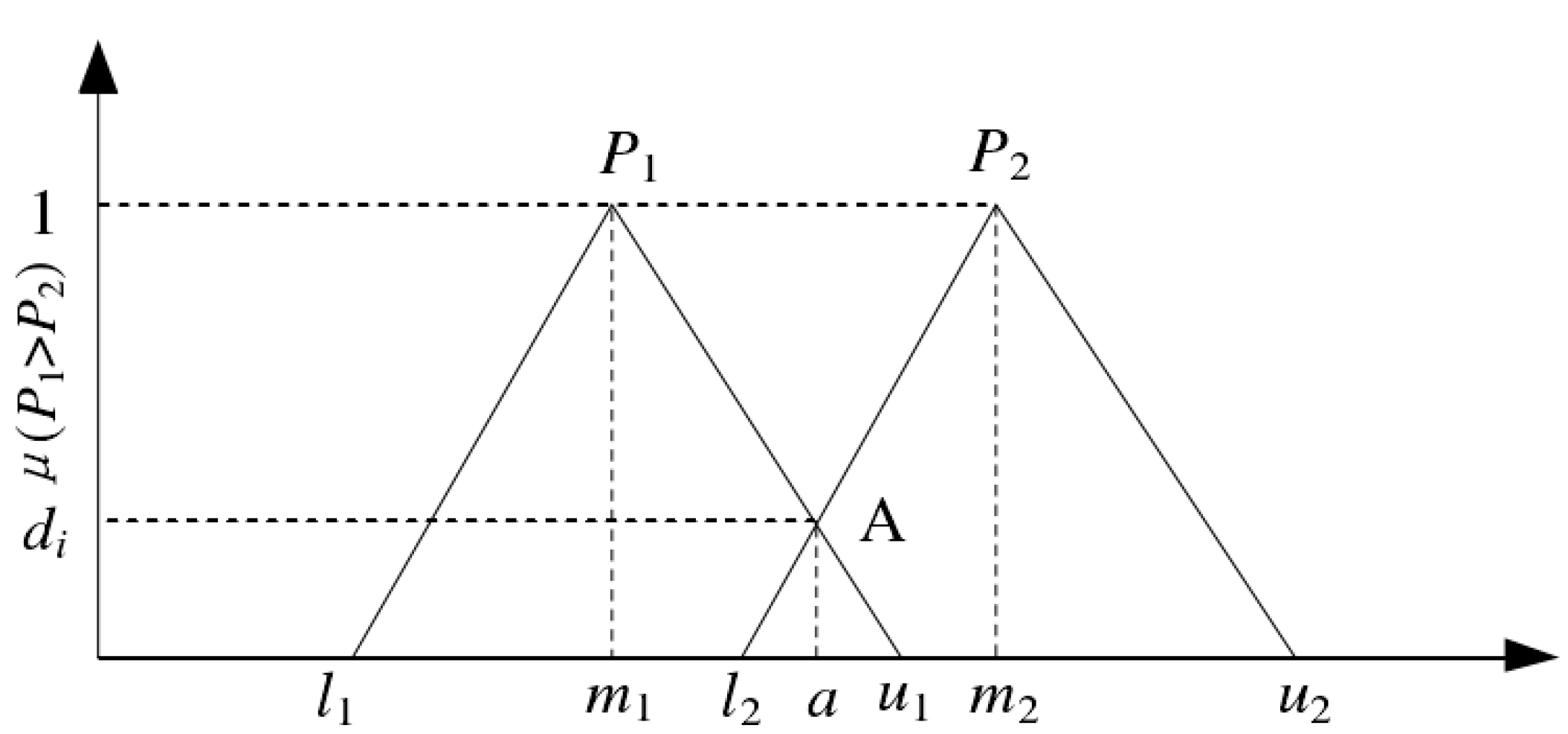
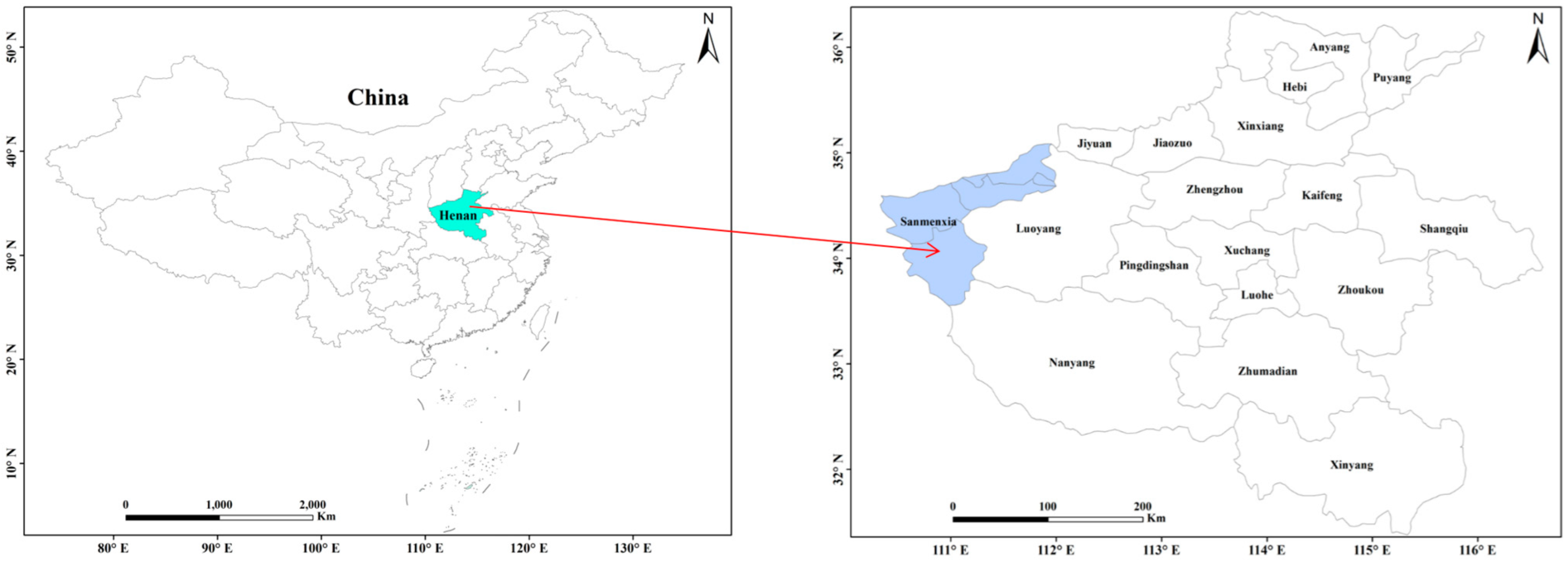

| Reduced Fuzzy Number | Triangular Fuzzy Number | Inverse |
|---|---|---|
| 1 | (1,1,1) | (1,1,1) |
| 1′ | (1,1,3) | (1/3,1,1) |
| 2′ | (1,2,4) | (1/4,1/2,1) |
| 3′ | (1,3,5) | (1/5,1/3,1) |
| 4′ | (2,4,6) | (1/6,1/4,1/2) |
| 5′ | (3,5,7) | (1/7,1/5,1/3) |
| 6′ | (4,6,8) | (1/8,1/6,1/4) |
| 7′ | (5,7,9) | (1/9,1/7,1/5) |
| 8′ | (6,8,10) | (1/10,1/8,1/6) |
| 9′ | (7,9,11) | (1/11,1/9,1/7) |
| Vulnerability Level | V |
|---|---|
| High | 0.8 ≤ V ≤ 1 |
| Medium-High | 0.6 ≤ V < 0.8 |
| Medium | 0.4 ≤ V < 0.6 |
| Medium-Low | 0.2 ≤ V < 0.4 |
| Low | 0 ≤ V < 0.2 |
| Index Layer | Sub-Index Layer | Investigation Content |
|---|---|---|
| Exposure | Population E1 | Number of employees E11 |
| Asset value E2 | Net value of fixed assets (million yuan) E21 | |
| Productivity E3 | Approved capacity (million tons) E31 | |
| Fortification | Elevation of well F1 | Whether the elevation of well is higher than the local highest flood level over the years F11 |
| Waterproof coal pillar F2 | Whether the waterproof coal pillar is reserved as required and not damaged F21 | |
| Whether the width of waterproof coal pillar is determined according to the width of water conducting fracture zone F22 | ||
| Subsidence and Crack F3 | Whether the subsidence and crack area are backfilled and compacted in time F31 | |
| Whether the water accumulation in subsidence and crack area is monitored F32 | ||
| Abandoned wells F4 | Whether the abandoned wells is blocked in time F41 | |
| Whether the abandoned wells is provided with drainage ditch at the wellhead F42 | ||
| Embankment project F5 | Whether flood control measures such as embankment construction and ditch excavation are taken F51 | |
| Resilience | Emergency plan R1 | Whether the emergency plan for rainstorm disaster has been prepared and regularly practiced R11 |
| Emergency material R2 | Whether emergency water pumps, pipelines, and other flood control and disaster relief equipment and materials are stored R21 | |
| Early warning mechanism R3 | Whether to actively coordinate with local meteorological, water conservancy, and other relevant departments to establish a flood disaster early warning mechanism R31 | |
| Management system R4 | Whether flood disaster prevention is included in the safety management system R41 | |
| Whether the inspection system for key parts and key links in rainy season has been established R42 | ||
| Whether emergency evacuation system is established when rainstorm may cause major danger R43 |
| Number | Coal Mine | E11 | E21 | E31 |
|---|---|---|---|---|
| 1 | Gengcun | 3924 | 52,369 | 360 |
| 2 | Guanyintang | 1160 | 16,387 | 45 |
| 3 | Shihao | 2301 | 30,441 | 120 |
| 4 | Liangjiawa | 400 | 4741 | 35 |
| 5 | Longwangzhuang | 947 | 47,551 | 70 |
| 6 | Jiuliuba | 343 | 13,044 | 45 |
| 7 | Changcun | 2999 | 29,830 | 180 |
| 8 | Qianqiu | 3121 | 20,746 | 150 |
| Number | Coal Mine | F11 | F21 | F22 | F31 | F32 | F41 | F42 | F51 |
|---|---|---|---|---|---|---|---|---|---|
| 1 | Gengcun | Yes | Yes | No | Yes | Yes | Yes | Yes | Yes |
| 2 | Guanyintang | Yes | Yes | Yes | Yes | Yes | Yes | Yes | No |
| 3 | Shihao | Yes | Yes | Yes | Yes | Yes | Yes | No | Yes |
| 4 | Liangjiawa | Yes | Yes | No | Yes | Yes | Yes | No | Yes |
| 5 | Longwangzhuang | Yes | Yes | No | Yes | No | Yes | Yes | Yes |
| 6 | Jiuliuba | Yes | Yes | No | Yes | Yes | Yes | Yes | No |
| 7 | Changcun | Yes | Yes | No | Yes | Yes | Yes | No | Yes |
| 8 | Qianqiu | Yes | Yes | No | Yes | No | Yes | Yes | Yes |
| Number | Coal Mine | R11 | R21 | R31 | R41 | R42 | R43 |
|---|---|---|---|---|---|---|---|
| 1 | Gengcun | Yes | Yes | No | No | Yes | Yes |
| 2 | Guanyintang | Yes | Yes | Yes | Yes | Yes | No |
| 3 | Shihao | Yes | Yes | No | No | Yes | Yes |
| 4 | Liangjiawa | Yes | No | No | Yes | Yes | Yes |
| 5 | Longwangzhuang | Yes | Yes | Yes | Yes | Yes | No |
| 6 | Jiuliuba | Yes | Yes | Yes | Yes | Yes | No |
| 7 | Changcun | No | Yes | No | Yes | Yes | No |
| 8 | Qianqiu | Yes | Yes | No | Yes | Yes | Yes |
| Indicators | Impact on Vulnerability | ||||||||
|---|---|---|---|---|---|---|---|---|---|
| 1 | 2 | 3 | 4 | 5 | 6 | 7 | 8 | 9 | |
| Exposure | |||||||||
| Population E1 | I | II | IV | ||||||
| Asset value E2 | II | II | II | I | |||||
| Productivity E3 | II | III | II | ||||||
| Fortification | |||||||||
| Elevation of well F1 | II | I | IV | ||||||
| Waterproof coal pillar F2 | I | II | III | I | |||||
| Subsidence and Crack F3 | I | II | II | II | |||||
| Abandoned wells F4 | I | II | IV | ||||||
| Embankment project F5 | II | III | II | ||||||
| Resilience | |||||||||
| Emergency plan R1 | III | II | II | ||||||
| Emergency material R2 | II | III | I | I | |||||
| Early warning mechanism R3 | I | III | II | I | |||||
| Management system R4 | II | II | II | I | |||||
| E1 | E2 | E3 | Si | Pi | |
|---|---|---|---|---|---|
| E1 | (1,1,1) | (1,2,4) | (2,4,6) | (4,7,11) | (0.195, 0.535, 1.444) |
| E2 | (0.25,0.5,1) | (1,1,1) | (1,3,5) | (2.25,4.5,7) | (0.11, 0.344, 0.919) |
| E3 | (0.17,0.25,0.5) | (0.2,0.33,1) | (1,1,1) | (1.37,1.58,2.5) | (0.067, 0.121, 0.328) |
| F1 | F2 | F3 | F4 | F5 | Si | Pi | |
|---|---|---|---|---|---|---|---|
| F1 | (1,1,1) | (4,6,8) | (1,3,5) | (1,1,3) | (2,4,6) | (9,15,23) | (0.139, 0.406, 1.016) |
| F2 | (0.125,0.17,0.25) | (1,1,1) | (0.25,0.5,1) | (0.2,0.33,1) | (1,1,3) | (2.575,3,6.25) | (0.04, 0.081, 0.276) |
| F3 | (0.2,0.33,1) | (1,2,4) | (1,1,1) | (0.25,0.5,1) | (1,2,4) | (3.45,5.83,11) | (0.053, 0.158, 0.486) |
| F4 | (1,1,3) | (1,3,5) | (1,2,4) | (1,1,1) | (1,3,5) | (5,10,18) | (0.077, 0.271, 0.795) |
| F5 | (0.17,0.25,0.5) | (1,1,3) | (0.25,0.5,1) | (0.2,0.33,1) | (1,1,1) | (2.62,3.08,6.5) | (0.04, 0.083, 0.287) |
| R1 | R2 | R3 | R4 | Si | Pi | |
|---|---|---|---|---|---|---|
| R1 | (1,1,1) | (1,3,5) | (3,5,7) | (2,4,6) | (7,13,19) | (0.168, 0.481, 1.254) |
| R2 | (0.2,0.33,1) | (1,1,1) | (2,4,6) | (1,3,5) | (4.2,8.33,13) | (0.101, 0.308, 0.858) |
| R3 | (0.14,0.2,0.33) | (0.17,0.25,0.5) | (1,1,1) | (0.25,0.5,1) | (1.56,1.95,2.83) | (0.037, 0.072, 0.187) |
| R4 | (0.17,0.25,0.5) | (0.2,0.33,1) | (1,2,4) | (1,1,1) | (2.37,3.58,6.5) | (0.057, 0.132, 0.429) |
| Number | Coal Mine | V | Vulnerability Level |
|---|---|---|---|
| 1 | Gengcun | 0.200067227 | Medium-Low |
| 2 | Guanyintang | 0.107329074 | Low |
| 3 | Shihao | 0.225151686 | Medium-Low |
| 4 | Liangjiawa | 0.085427451 | Low |
| 5 | Longwangzhuang | 0.154034211 | Low |
| 6 | Jiuliuba | 0.08499586 | Low |
| 7 | Changcun | 0.402844514 | Medium |
| 8 | Qianqiu | 0.205216119 | Medium-Low |
Publisher’s Note: MDPI stays neutral with regard to jurisdictional claims in published maps and institutional affiliations. |
© 2022 by the authors. Licensee MDPI, Basel, Switzerland. This article is an open access article distributed under the terms and conditions of the Creative Commons Attribution (CC BY) license (https://creativecommons.org/licenses/by/4.0/).
Share and Cite
Sun, Z.; Qi, Q.; Liu, Y. Vulnerability Assessment of Mine Flooding Disaster Induced by Rainstorm Based on Tri-AHP. Sustainability 2022, 14, 16731. https://doi.org/10.3390/su142416731
Sun Z, Qi Q, Liu Y. Vulnerability Assessment of Mine Flooding Disaster Induced by Rainstorm Based on Tri-AHP. Sustainability. 2022; 14(24):16731. https://doi.org/10.3390/su142416731
Chicago/Turabian StyleSun, Zuo, Qingjie Qi, and Yingjie Liu. 2022. "Vulnerability Assessment of Mine Flooding Disaster Induced by Rainstorm Based on Tri-AHP" Sustainability 14, no. 24: 16731. https://doi.org/10.3390/su142416731
APA StyleSun, Z., Qi, Q., & Liu, Y. (2022). Vulnerability Assessment of Mine Flooding Disaster Induced by Rainstorm Based on Tri-AHP. Sustainability, 14(24), 16731. https://doi.org/10.3390/su142416731








